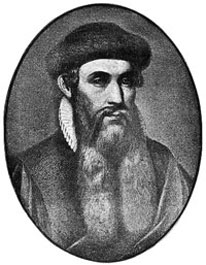In Books

the Soncino Press
The first printing house in Europe was established by a German named Johann Gutenberg. The first book that was published in his printing house was actually none other than the Bible!
The first Jewish printing houses were established in Spain and Italy, where holy Jewish scripts were published, serving the Jewish community both nationally and abroad. Most Jewish printing houses were owned by Jews, however there were exceptions, such as the printing house of Daniel Bombirago, who was a gentile but nevertheless owned a printing house that published large quantities of Jewish books.
One of the first Jewish printing houses was that of the Soncino family, an Italian Sephardic Jewish family whose ancestors were among the Baalei Tosfot. The head of the family, Rabbi Moshe Shapiro, had lived during the beginning of the sixth century and his commentaries are recorded in the Tosfot of Rabbi Moshe of Ibura, Rabbi Eliezer Matuch and Rabbi Peretz Bar Eliyahu of Korveil. His descendant, Rabbi Moshe, was renowned for his physical strength. He fought alongside the Turkish Ottoman soldiers against the infamous monk Juan de Capistrano and became well-known as a mighty warrior.
The sons of Rabbi Moshe, Shmuel and Shimon, were forced to leave their hometown of Pirta due to persecution against Jews. They relocated to the city of Soncino and changed their last name to the name of the city.
Shmuel Soncino had a son named Israel Nathan, who was a doctor and a great Torah scholar. He wished to publish Jewish books in order to make the learning experience more accessible to the broader Jewish community. He encouraged his own son, Yehoshua Shlomo, to establish a printing house that would publish Jewish scripts. Yehoshua Shlomo indeed began the process of establishing a printing house, and soon all his brothers joined him as well. The printing house was finally opened in 5244, and published books in Soncino and Napoli until the year of 5252.
One of the first books that was printed in the Soncino printing house was Tractate Berachot with the commentaries of Rashi and the Baalei Tosfot. It was also the very first time that a Talmudic tractate was printed in the fashion we know today; the teachings of the Emora'im in the center of the page and the commentaries of Rashi and the Tosfot added around the central text. This structure had remained with us to this day. In the prefix of the tractate, the Soncino brothers described how the printing house came to exist: 'And so it was that our father, the scholar and G-d fearing person Rabbi Israel Nathan, the son of Rabbi Shmuel, saw that many thirsted for words of wisdom but could not find them, as they could not afford to buy books…and so he called upon his son Rabbi Yehoshua Shlomo who lives in the city of Soncino and told him: 'you will build an important building that will open up the gates of wisdom'…and there are two benefits from this printing house; the first, that many books can be printed fast until the whole world will be filled with the knowledge of G-d, and the second that the price of the books will be lesser than books written by an iron or lead pen. And the son hurried to fulfill his father's request and opened this printing house to glorify G-d's name, and printed this tractate with the commentaries…'
Shmuel Soncino passed away in 5245, Israel Nathan passed away in 5251, and Yehoshua Shlomo passed away in 5253.
Yehoshua Shlomo had a brother named Moshe, whose sons were printers, however it is unknown whether he himself was active in the family business or not. One of his sons, Shlomo Soncino, published the Arba Turim which was written by Rabbeinu Yaakov ben Asher in the year of 5250, and yet another son, Gershon Soncino, established several printing houses in Soncino, Brescia, Barco, Fano, Salonica and Constantinople. His printing houses were active between the years of 5249 and 5294, and printed thousands of Jewish books.
Gershon Soncino invested much time and effort, as well as money, in order to spread the wisdom of the Torah throughout Europe, and was constantly searching for lost and hidden scripts which he would then print for the benefit of the Jewish world. Gershon employed numerous artists in his printing houses, who would painstakingly cut out all the letters and prepare them for printing. They would also create beautiful decorations to the books that Gershon printed. During the decade of 5254 – 5264, Gershon Soncino was the only Jewish printer in the world. Except for being a printer, he was also a great philanthropist who generously assisted the expelled Jews from Spain and Portugal. Gershon's life was not always carefree and peaceful, however, as he suffered immensely from the gentile printer Daniel Bombirago, who would copy from Gershon's books and print them in his own printing houses. In the year of 5288, Gershon left Italy, and many people estimate that he was expelled from the country following a heated argument with the convert from Judaism Marano, a representative of Daniel Bombirago.
The sons of Gershon were also printers; Moshe Soncino established his own printing house and Eliezer Soncino joined his father Gershon. Eliezer continued to run the printing houses of his father even after Gershon's passing, until his own passing in 5307, when the printing house was bought by a partner of the Soncino family.
The last printer belonging to the Soncino family was Gershon Soncino, a son of Eliezer Soncino and a grandson of the first Gershon Soncino. His printing house was located in Egypt and the only book we know of that was printed there was the 'Sefer Refuot' – the medicine book of the Talmud.
Some historians maintain that the first printing house that was established in Prague in 5272 belonged to ancestors of Israel Nathan Soncino, however no proofs have been found to validate the theory.
(Motty Meringer)






